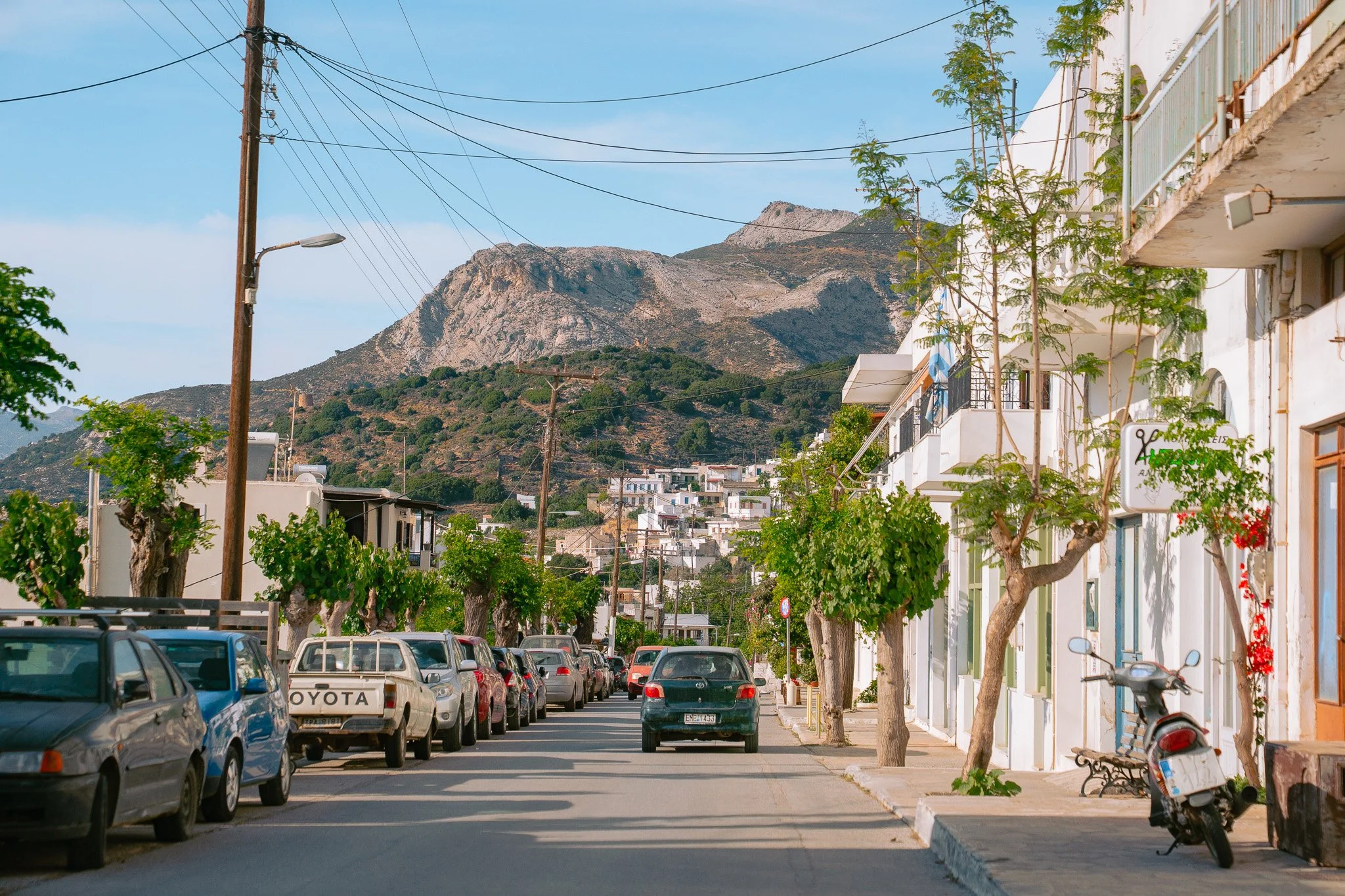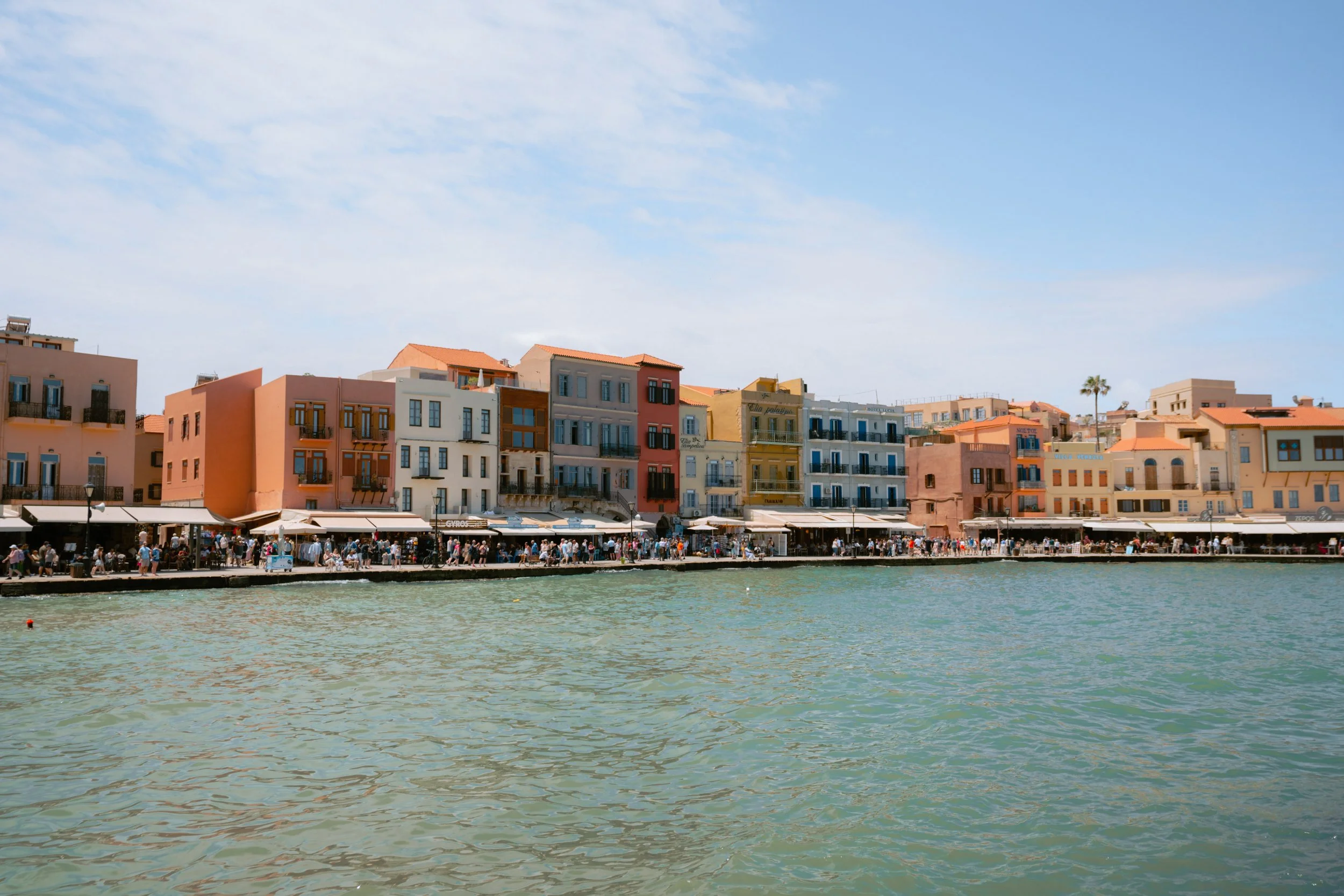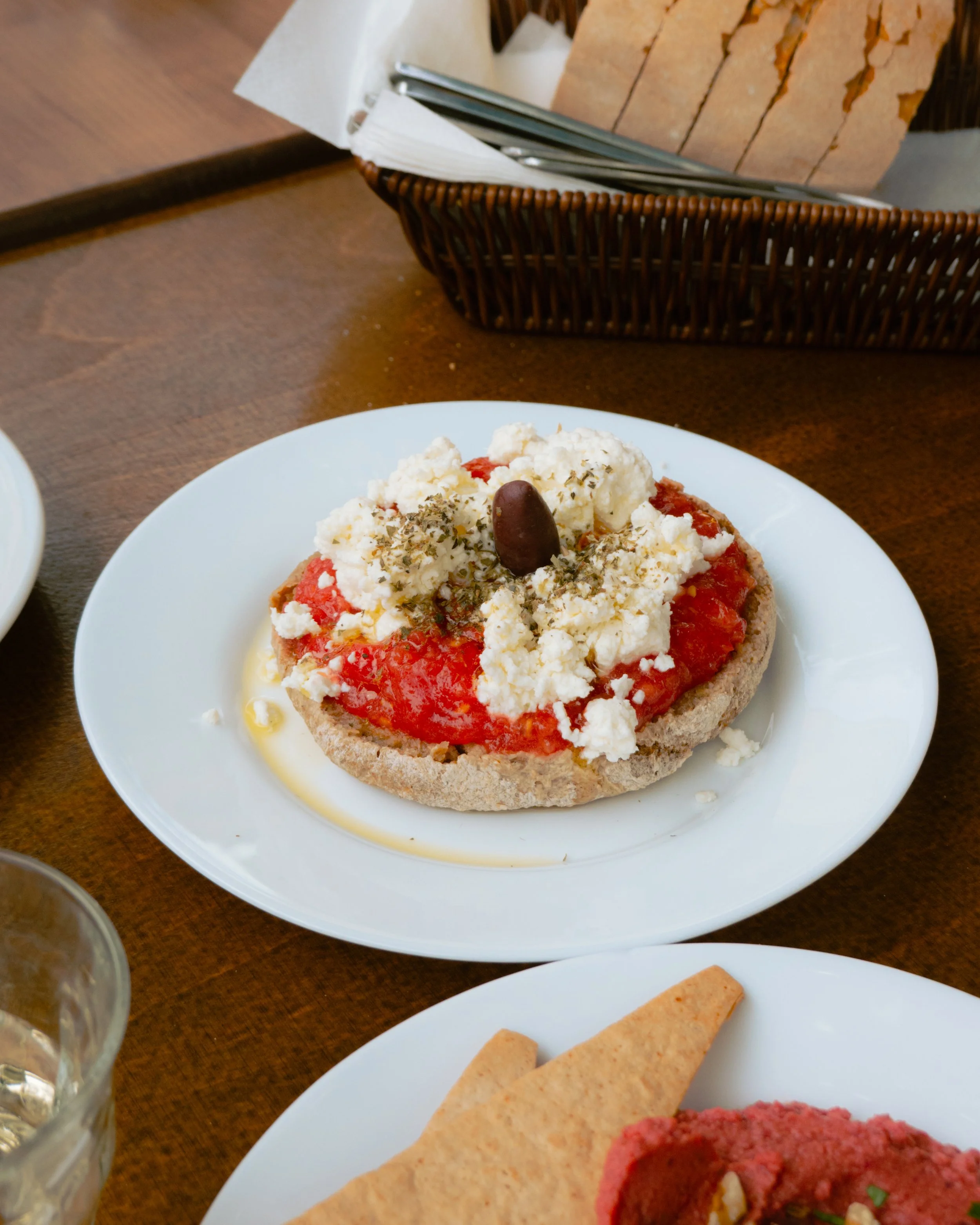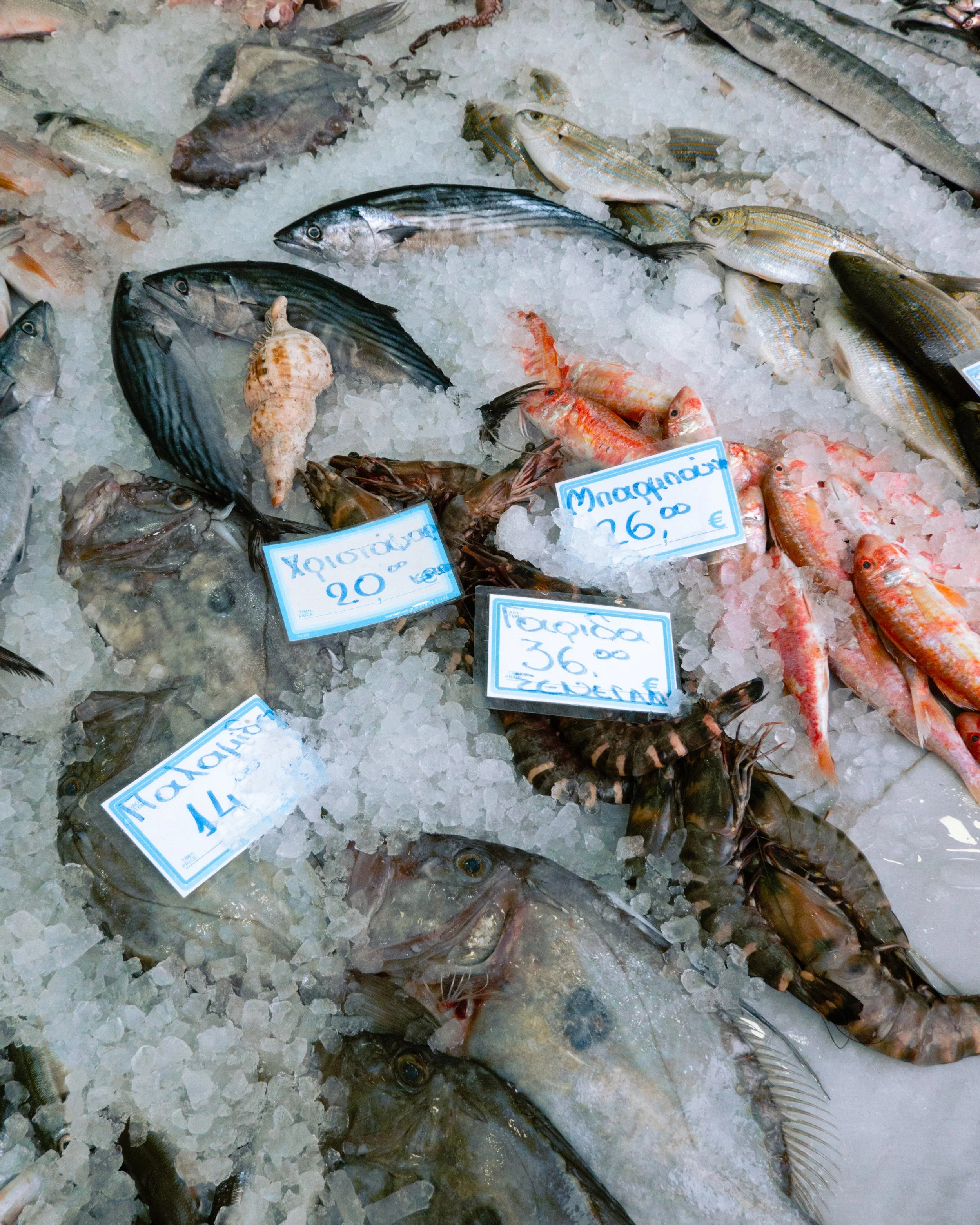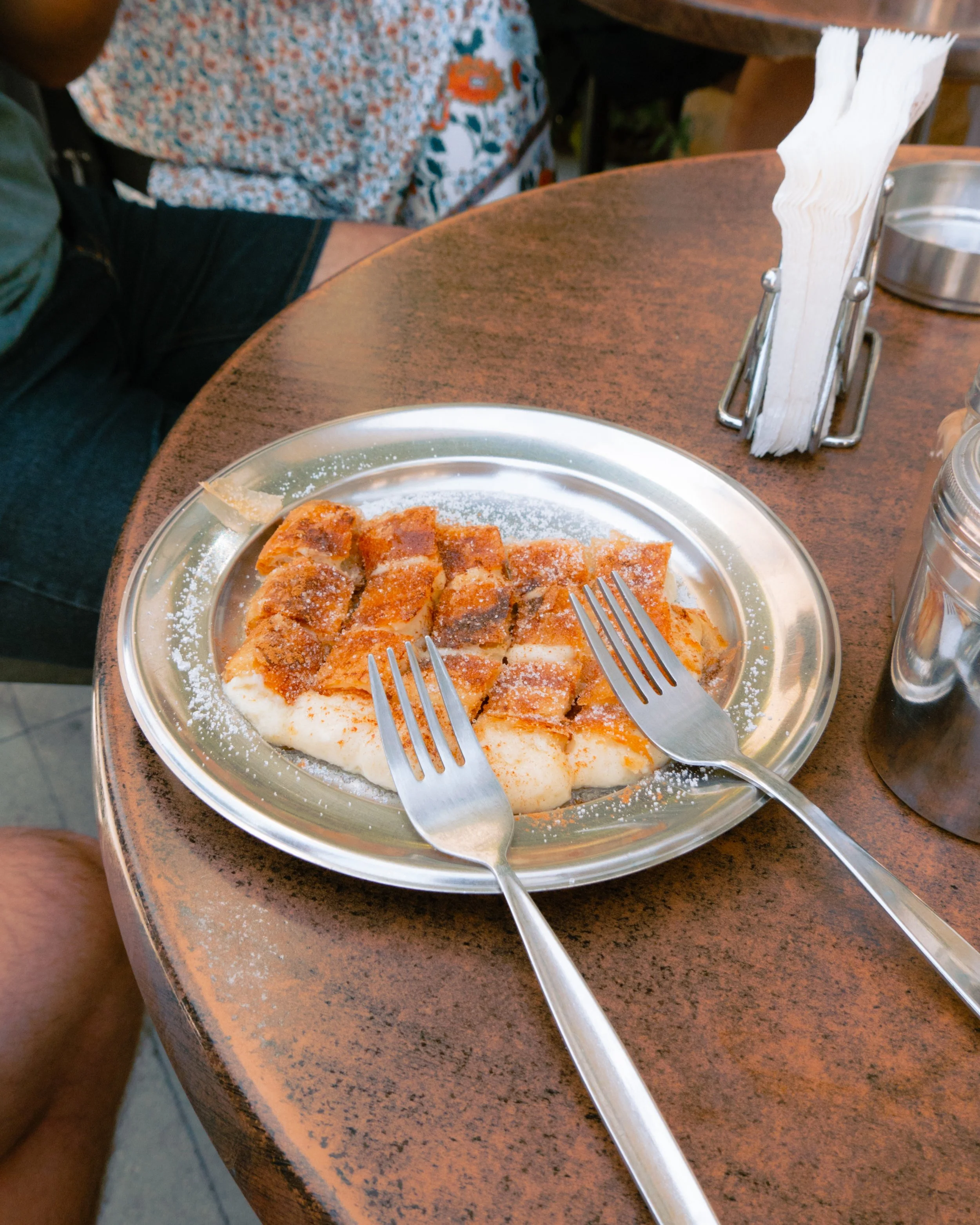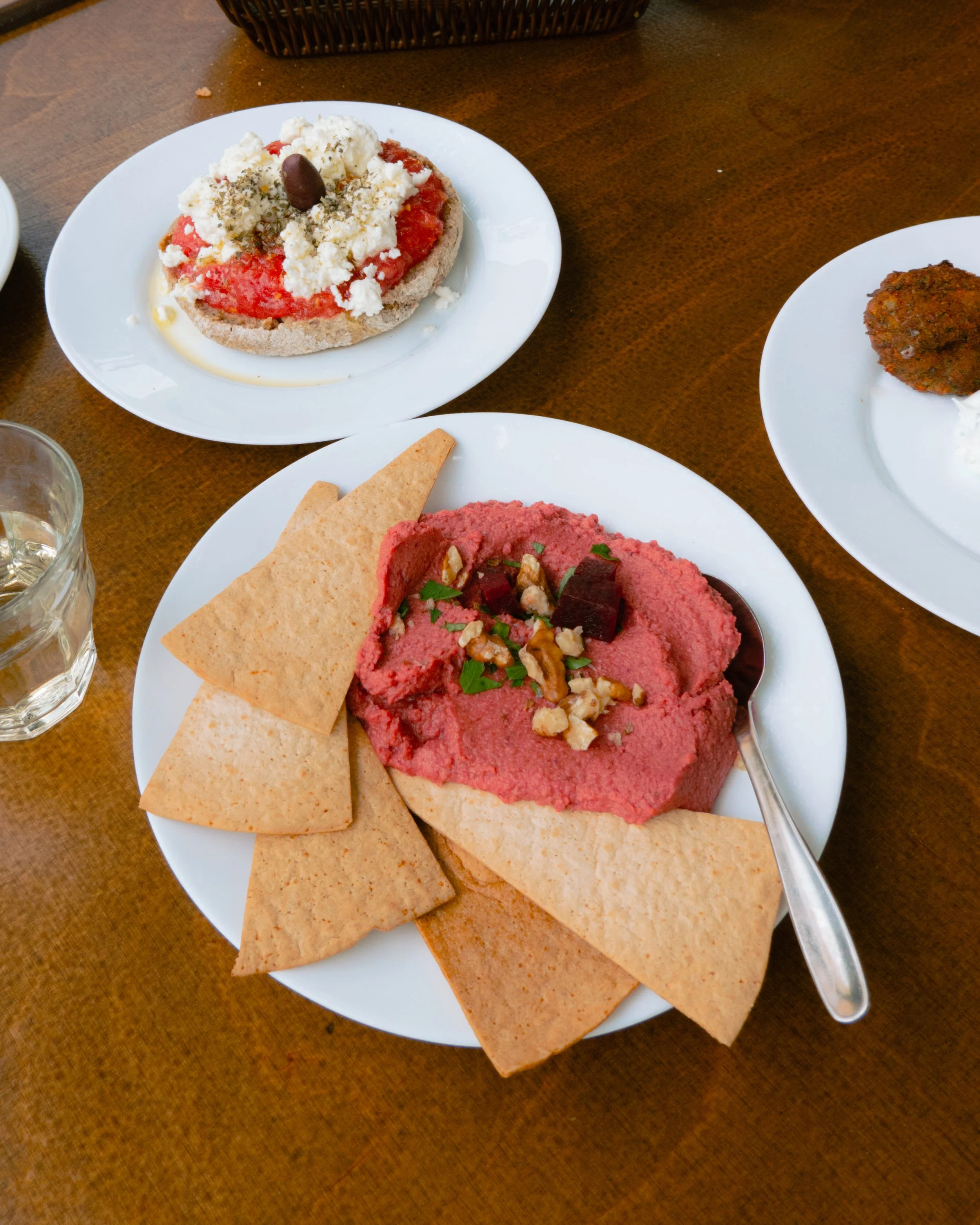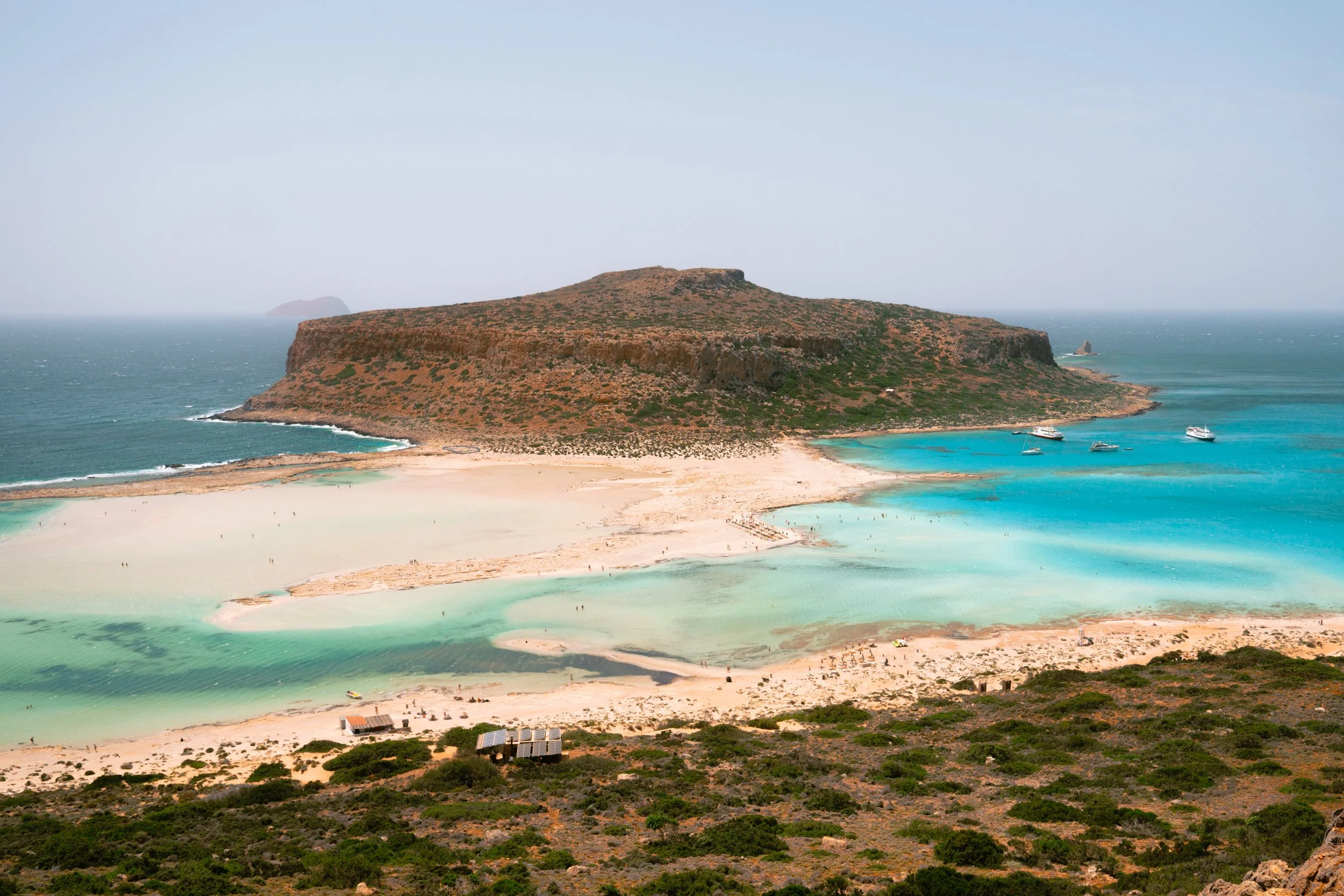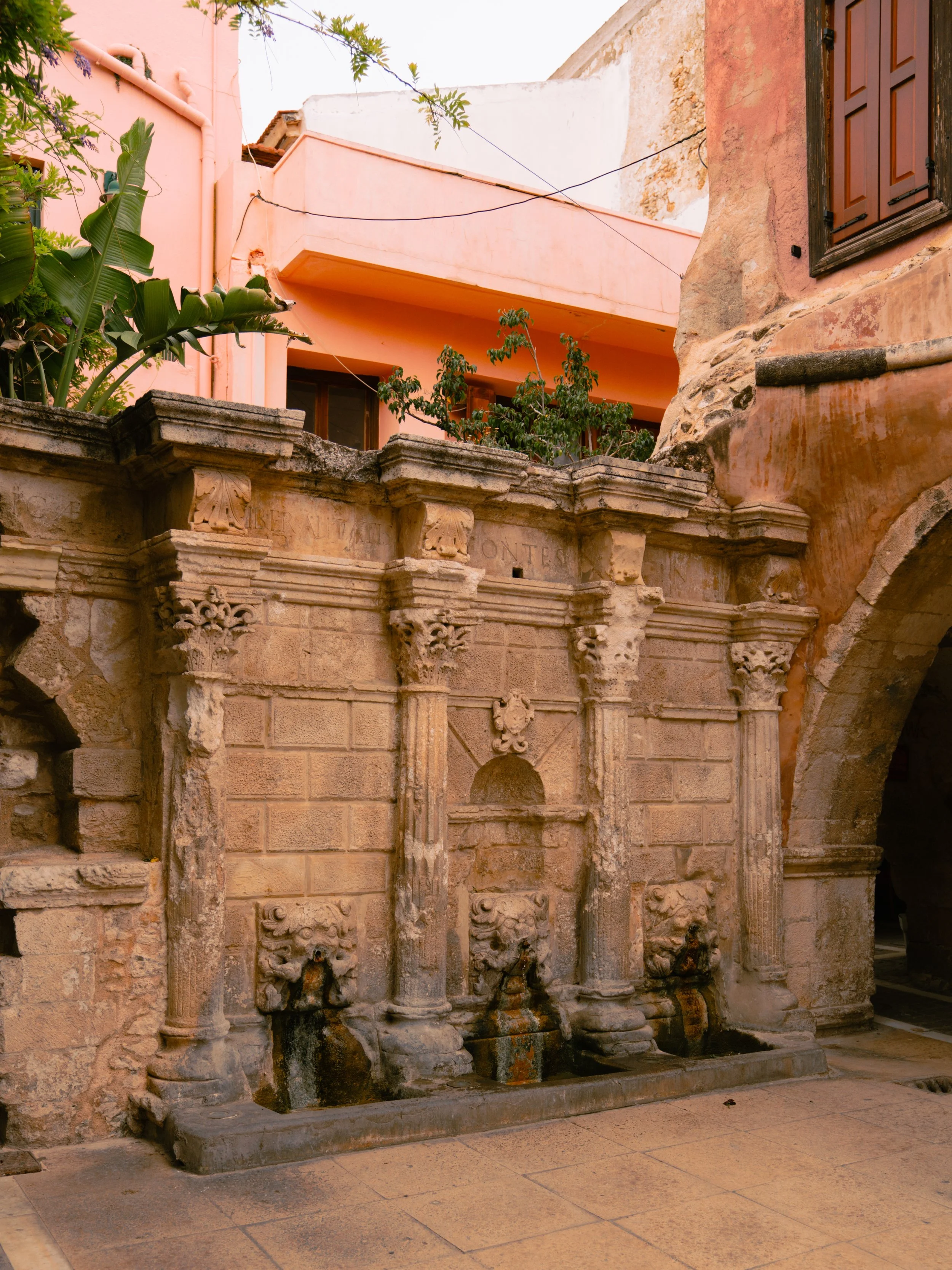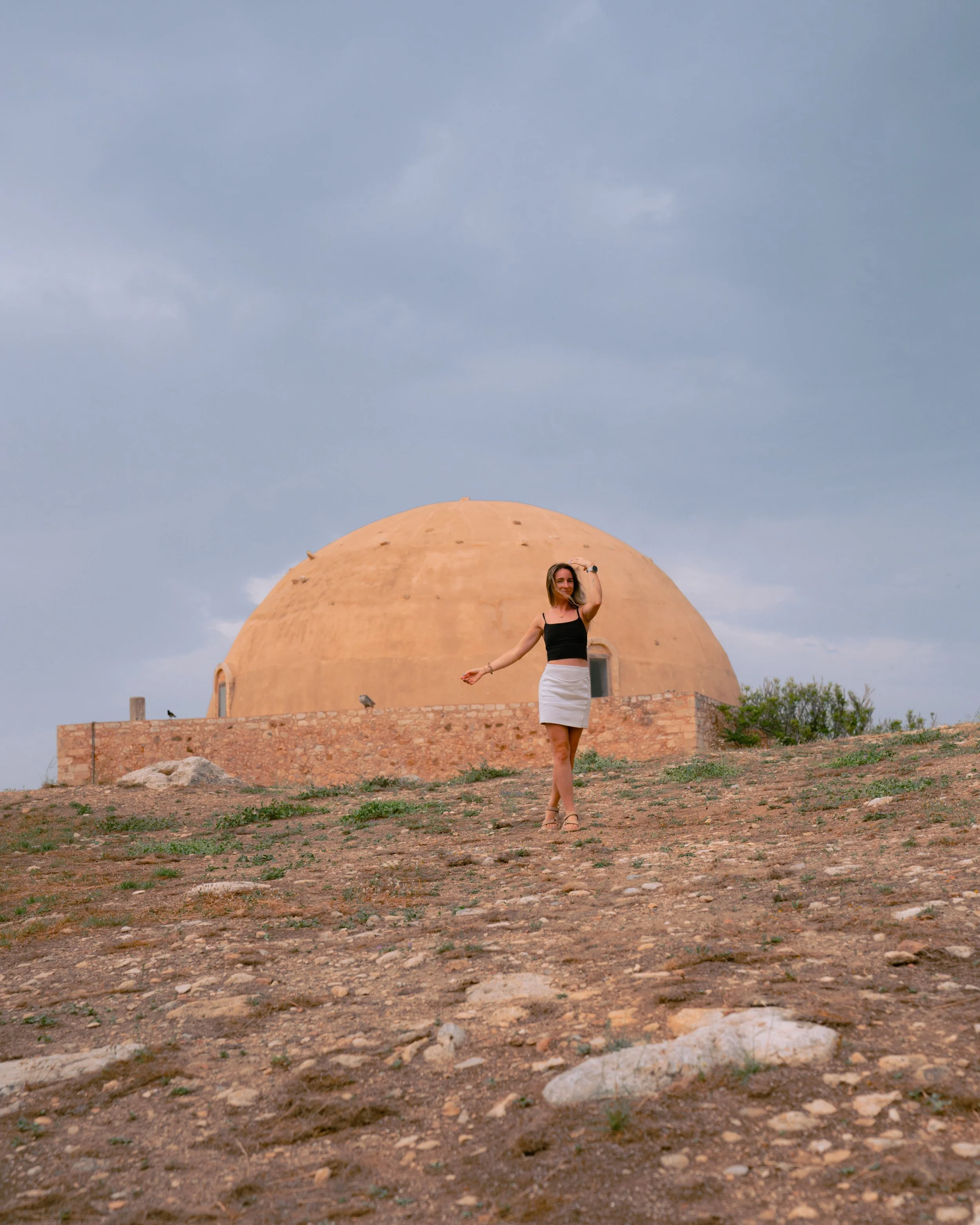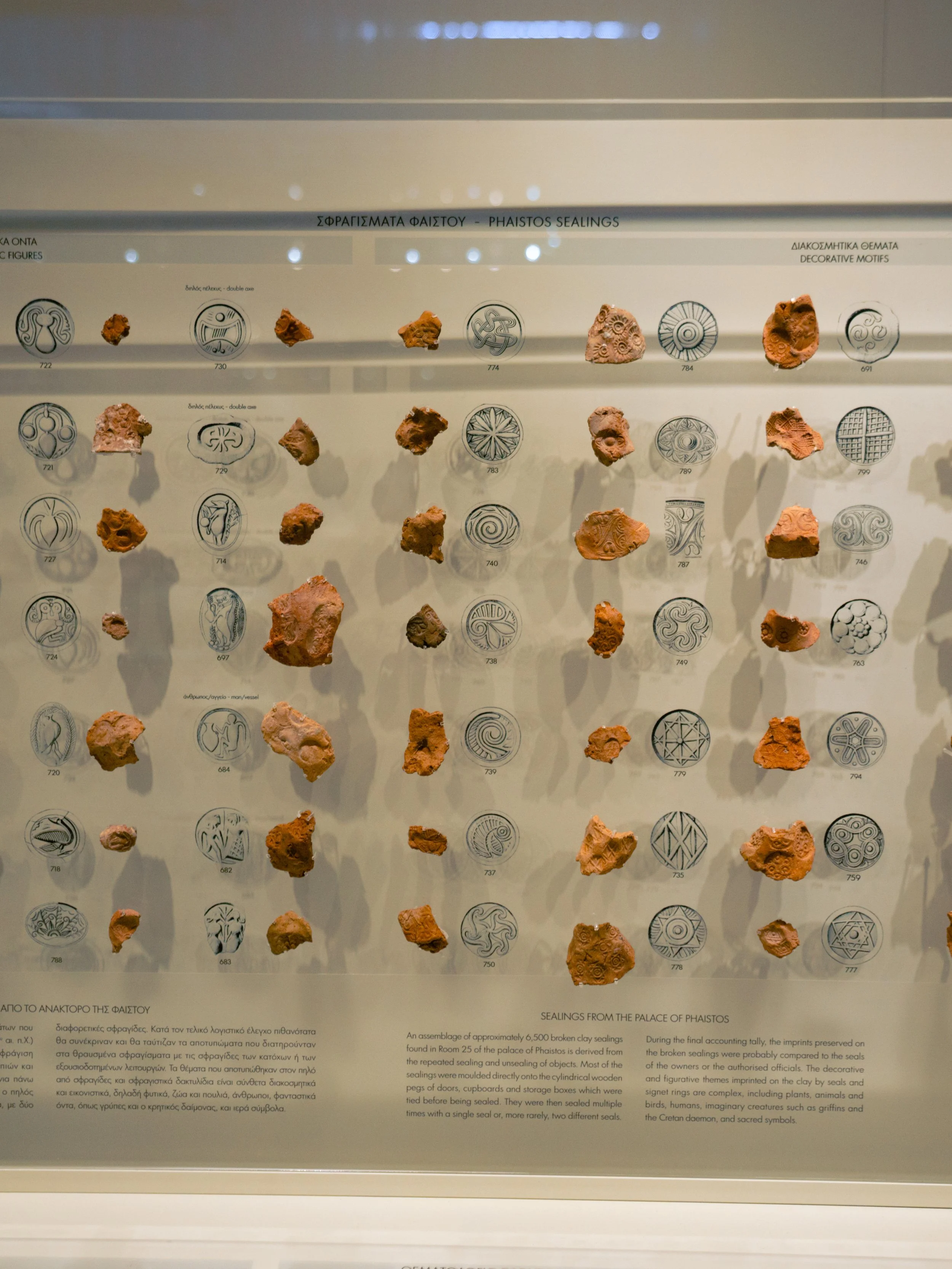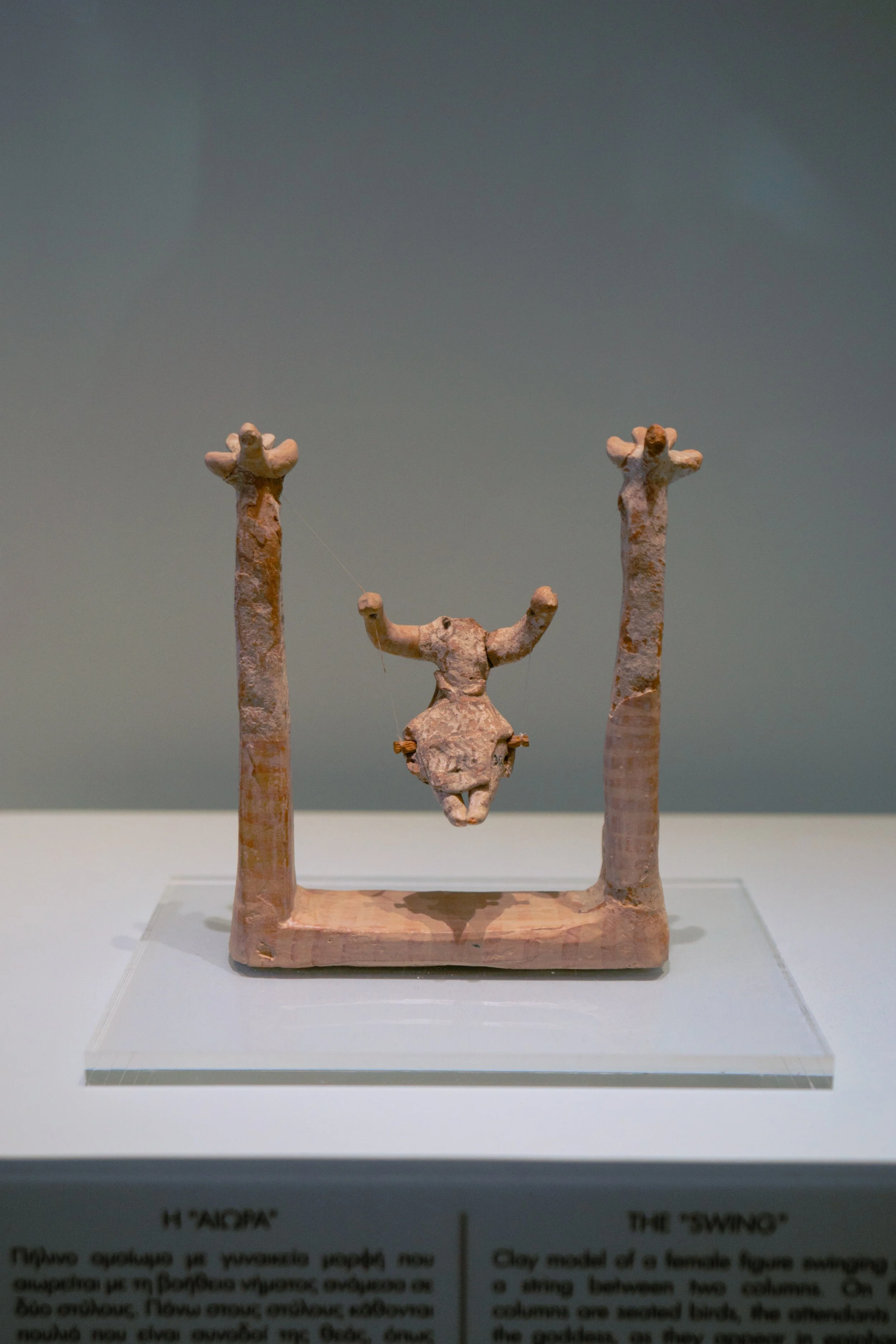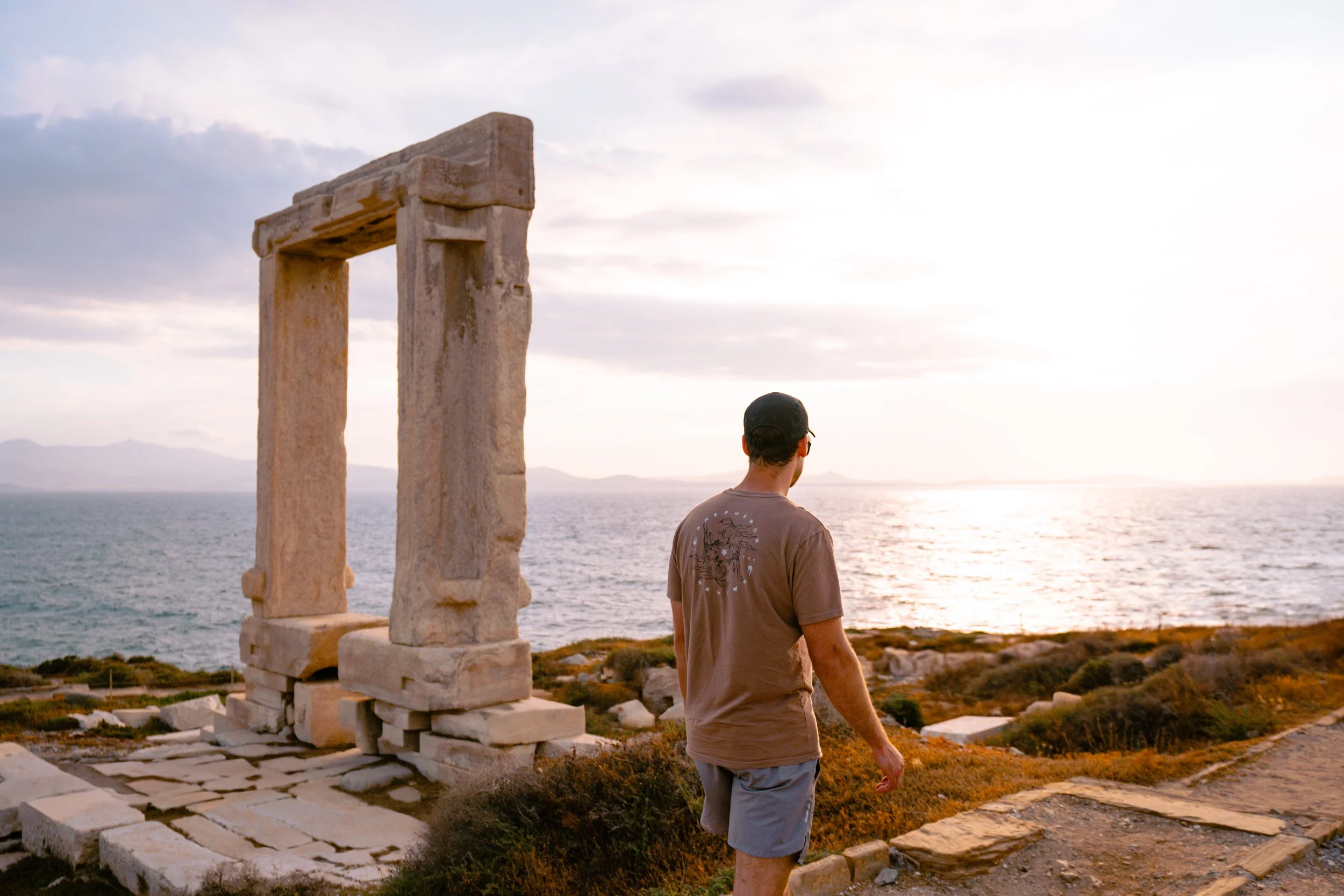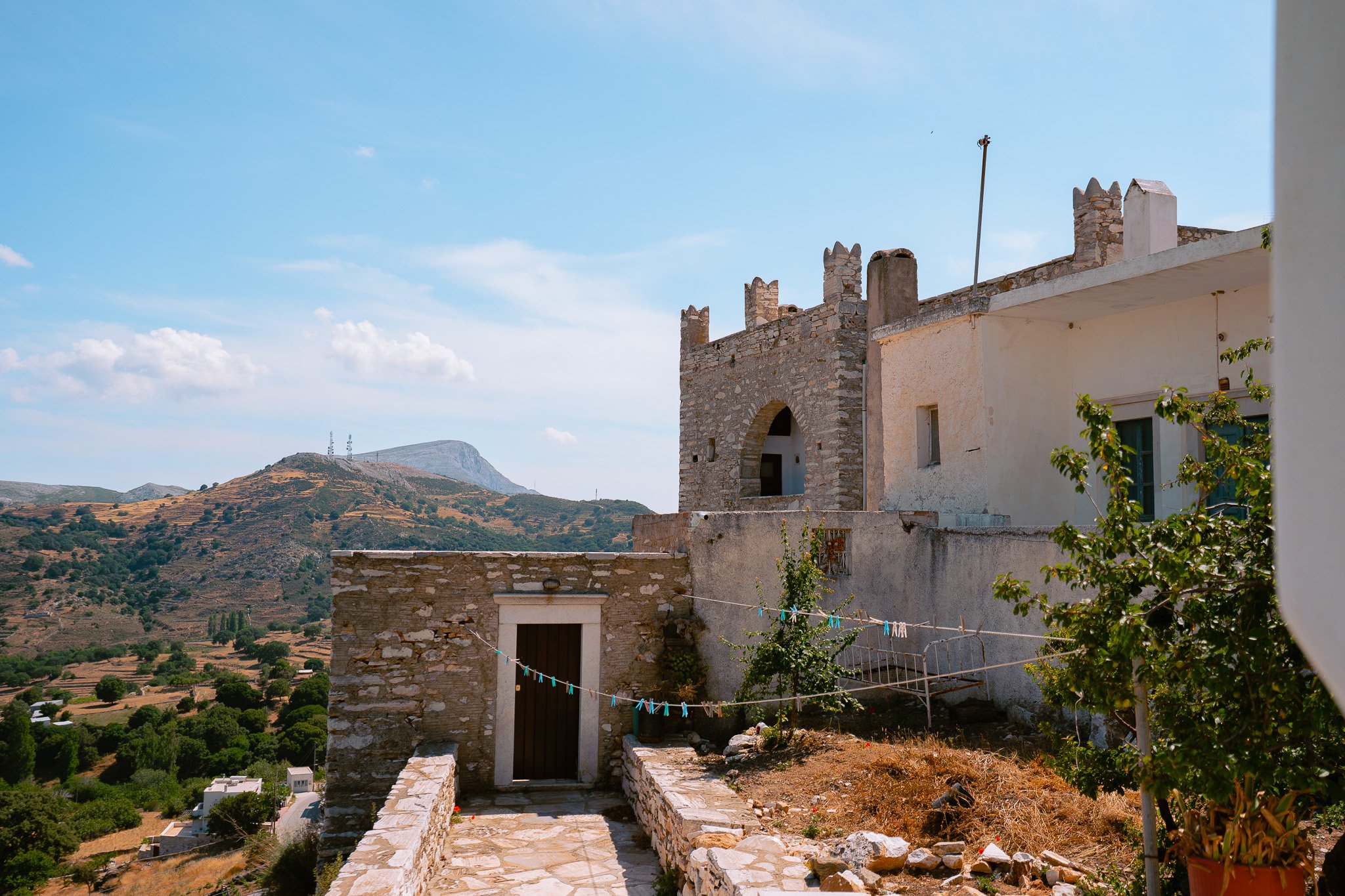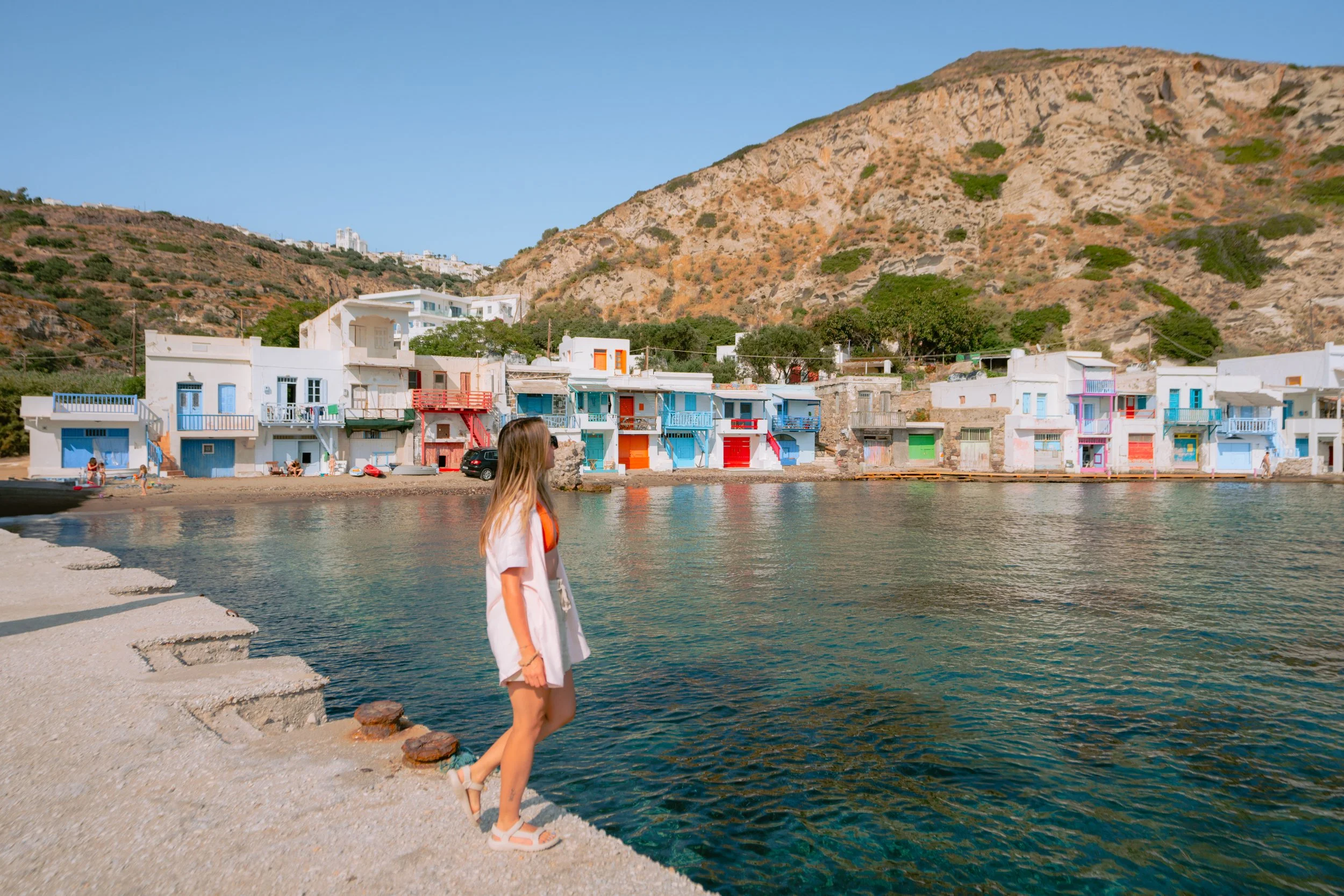Postcards from Greece: Exploring Crete, Naxos, Milos, and Athens
Firopotamos Beach
In late May, Tim and I set off on a 2 and a half week island-hopping adventure across Greece — starting in Crete and making our way through Naxos, Milos, and finally Athens. We hiked mountain peaks with views of the Mediterranean sea, swam in crystal-clear water, wandered through ancient ruins, ate our bodyweight in feta and olives, and discovered that in Greece, every meal comes with a sweet treat (or a shot of liquor).
This wasn’t a flop-on-the-beach type of trip (though we definitely did that too). It was part adventure, part culinary journey, part ancient history immersion, and part “how do we get out of this narrow street without scratching our rental car”…all in the best way. Greece has this way of making even the chaotic parts feel charming, and I felt an immediate love for its friendly people, its glorious sunsets, and all of its myths and legends.
Below is our full day-by-day itinerary with tips on where to eat, swim, hike, and explore — along with what we’d do differently.
So whether you’re planning your own Greek escape or just living vicariously through this post, I hope it helps you fall in love with Greece the way we did!
Itinerary Overview
This itinerary covers our full island-hopping adventure across Greece, with a mix of beach time, mountain hikes, and historic ruins. We rented cars in each place (minus Athens) and traveled by plane and ferry between islands. We stayed in boutique hotels and an Airbnb throughout our trip.
Here’s what we covered at-a-glance:
4 nights in Chania (Crete)
2 nights in Heraklion (Crete)
4 nights on Naxos
4 nights on Milos
3 nights in Athens
Getting Around Greece: Flights, Ferries & Car Rentals
Driving around Naxos
We flew from Denver to Heraklion (with a layover in Frankfurt) to kick off the trip in Crete. From there, we took ferries to Naxos and Milos, and finally caught a quick flight from Milos to Athens since we were ultimately flying home out of Athens.
Here’s what we learned about getting around:
✈️ Flying In & Out
Fly into Heraklion or Chania airport when traveling to Crete. Heraklion Airport is small and easy to navigate, even when jet lagged.
Milos to Athens flight was fast (less than 40 minutes) and surprisingly convenient. The airport in Milos is tiny — you don’t even go through security until you’re boarding. Overhead space on the plane was tight, so we had to check a bag unexpectedly, but it arrived in Athens safe and sound.
Fly out of Athens to catch international connections back to the U.S.
⛴️ Ferries Between Islands
We booked all our ferries in advance through FerryHopper, which I highly recommend — it’s easy to compare times, prices, and operators.
The Heraklion to Naxos ferry was straightforward and took about 3 hours.
The Naxos to Milos ferry was surprisingly long (about 4.5 hours) because it stopped at Paros, Sifnos, and a couple other islands. If we did it again, we’d consider staying on Paros for a night or two to break up the journey. Check the ferry schedule FIRST, then decide on your island itinerary.
Ferries are comfortable but loud, so bring headphones, snacks, and a light jacket (AC is cranked). Some of the ferries are bumpy if it’s windy, so bring Dramamine if you’re prone for sea sickness (it was ROUGH from Naxos to Milos, like could barely stand up to walk down the aisle to the bathroom rough).
🚗 Car Rental
When it came to car rentals, we picked up a car in each destination separately rather than booking one long-term — which gave us more flexibility and avoided the hassle of bringing a vehicle on ferries (you’ll usually pay extra for that). Be aware that Google Maps is not always accurate and might try to take you down small, winding roads through villages that are barely accessible — keep your wits about you, and you’ll be okay! Here’s how we handled it:
Crete: A car is essential here — Crete is the biggest island in all of Europe! We rented one for our time in Chania and Heraklion, and it made exploring beaches, mountains, and small towns super easy. Just be prepared for winding coastal roads and keep your eyes out for goats!
Naxos: Definitely recommend having a car as Naxos is the biggest island in the Cyclades. We rented a small car from Motonaxos, which was affordable and a rental agent met us right at the port as we got off. Driving around the island was straightforward, and parking was never a problem.
Milos: In hindsight, an ATV would’ve been much better than a car — the island is small, the roads are narrow, and the parking situation favors smaller vehicles. Also, it looked way more fun!
Athens: No car needed! We walked almost everywhere and used cabs for a few longer transfers. Honestly, you don’t want to drive in Athens unless you’re very confident navigating chaotic city traffic.
Pro tip: Greek hospitality is strong. If you're ever in a pinch, your hotel or Airbnb host will likely help you coordinate a ride or connect you with a local rental agency.
What to Wear in Greece
We visited in late May through early June, and it was pretty warm almost every day — especially in the afternoons — but a few spots had cooler evenings, especially near the coast or at higher elevations. We also experienced a few windy days AND a wind storm in Crete that blew in dust from the Sahara which turned the sky orange. But, aside from that, the weather was lovely.
Here’s what I actually wore (and how I’d pack differently next time).
Dressy, beachy loungewear — Lightweight cotton and linen were my uniform. Neutral skirts, bright colored tops. Think airy dresses and breathable tops. A few of my favorites are below:
prAna Hideaways Dress — great as a beach cover up or to wear while exploring
lululemon 2-in-1 Maxi Dress — both a dress AND a skirt, such a vibe too!
lululemon Align Cami Strap Dress — athleisure dresses were PERFECT for the islands
fp movement All Clear Solid Cami — think bright colors paired with flowy white linen pants or the lulu skirt *chef’s kiss*
Swimsuits & cover-ups — Bring multiple swimsuits! I kept a swimsuit under my clothes most days just in case, especially on Naxos and Milos.
Footwear — I rotated between four pairs of shoes, although in retrospect I would’ve only brought one pair of sandals and the trail runners.
Teva Hurricane XLT2 Sandals were my legitimate go-to for almost everything, from hiking, to beaches, walking around villages and they were so incredibly comfortable. Tim had the same pair and wore his almost everywhere, too!
Teva Hurricane Drift sandals for beach days and walking around villages.
HOKA Speedboat Trail-Running Shoes were great for traveling, hiking, running, and didn’t take up too much space.
VEJA Campo Leather Shoes — admittedly, I barely wore these and probably didn’t need a second pair of walking shoes.
Evening layers — I packed a few light long sleeves which were perfect for breezy nights on Milos and Naxos, but I definitely did not need multiple pairs of sweatshirts or sweat pants. You won’t need heavy layers unless you're heading into the mountains (and even hiking Mount Zas, the tallest peak in the Cyclades, was not too cold).
Other essentials:
A wide-brim hat or cap
Sunglasses and sunscreen
Crossbody bag or small daypack for short hikes and village wandering
Beach tote or backpack
Dry bag to protect camera gear on boat rides and beaches
A scarf or shawl to use when visiting monasteries (shoulders and knees should be covered)
Day 0: Arrival
Venetian Harbor in Chania
We landed in Chania and checked into Balance Hotel, where Sofia at the front desk greeted us with a little Greek yogurt topped with strawberry jam. It was creamy and sweet, a welcome snack that set the tone for what would become a very food-focused trip. We grabbed some late-night gyros around the corner before crashing. We slept deeply — our hotel was quiet but conveniently located near downtown, super clean, stylishly decorated, and the room was incredibly spacious. I would highly recommend staying here when visiting Chania!
Day 1: Chania Food Tour & Seitan Limania
Our first morning kicked off with an incredible tour that we booked through GetYourGuide called Chania: Old Town Highlights Guided Tour with Street Food. Our guide, Manos, was full of local knowledge and introduced us to a delicious spread of Cretan staples. We sampled bougatsa and watched it get made (a fresh, flaky pastry filled with mizithra cheese and dusted with powdered sugar), several local cheeses including tangy mizithra, and fresh olives, honeys, and jams, and of course, souvlaki and gyros. We also had a few sips of raki — the strong Cretan spirit served with nearly every meal — and learned a few useful Greek words: "ya sas" (hello/goodbye) and "efcharistó" (thank you). Food is such a big part of Cretan culture that I would highly recommend kicking off your trip with this experience.
Seitan Limania Beach
After the tour, we ventured to Seitan Limania Beach, a stunning turquoise cove tucked between dramatic cliffs. The drive was winding but manageable, and we hiked down the rocky trail in our Teva sandals without issue. Along the way, we spotted our first Greek goats, casually roaming the hillside. The beach itself was small but jaw-droppingly beautiful, and the chilly water was refreshing after the hike.
For dinner, we booked a table at Kanelis — a lively taverna with live music and known for its delicious lamb. We devoured dolmadakia (grape leaves stuffed with rice), zucchini blossoms, saganaki (fried cheese), lamb with pilaf rice, and paired it all with some house red wine. A little sweet treat paired with raki arrived unprompted. The atmosphere was cozy, the portions generous, and the hospitality unmatched.
Day 2: Balos Beach & Dinner in Gramvousa
We kicked off the day with a full Cretan breakfast at Phyllos in downtown Chania. If you’re a fan of mezze-style dining, you’ll love this place — olives, mizithra cheese, dakos (Cretan barley rusk with tomato and feta), yogurt drizzled with honey, eggs, meats…it was a feast. Highly recommend ordering a bunch of small plates to share.
Balos Beach
Then came the adventure: a drive to the legendary Balos Beach. I had been equally excited and nervous about this one — the drive is known for being rough, with a bumpy, unpaved road for the last several kilometers. Go slow, avoid low-clearance cars, and you’ll be fine (though we did pass someone with a flat tire, so be prepared). Bring cash to pay for parking (and to use the small bathroom in the parking lot), or be prepared to pay with card at the cantina down in the parking lot. After parking, it’s a short but steep hike down to the beach with sweeping views of the turquoise lagoon below — arguably one of the most photogenic spots in Greece.
It was very windy when we visited, which made for dramatic waves and a bit of a sandy exfoliation experience, but it was still a highlight of the trip. Goats and cats roamed freely, as they do, and the shallow water was perfect for wading and soaking up the views. Definitely bring water, sturdy sandals, and sun protection. There’s also a small cantina on the beach with pizza, drinks, fruit, and other snacks.
After hiking back up, we drove to Gramvousa Restaurant nearby and sat down to one of the most memorable meals in Crete. I ordered grilled octopus that was charred to perfection — slightly chewy but so flavorful. For appetizers, we shared dolmadakia (grape leaves stuffed with rice, served with yogurt), and a fried potatoes with eggs and staka (melted sheep’s butter). Cats were wandering freely about the patio — I caved and fed them the chewy bit from my octopus and our table was very quickly completely surrounded by cats…just how I wanted it.
Day 3: Rethymno, Preveli Beach & A Saharan Dust Storm
We had breakfast again at Balance Hotel and set off for a road trip along the coast toward Rethymno. The weather took a dramatic turn: powerful winds and then, later, a thick orange haze rolled in due to Saharan dust in the atmosphere. A truly wild phenomenon that made everything look like we were walking through a sepia-toned photo filter.
We visited the Fortezza of Rethymno, a massive Venetian fortress from the 16th century with panoramic sea views. Entry was inexpensive, and you can wander through old stone barracks and watch the waves crash into the coastline below. But honestly, it was hard to enjoy it fully with 40 mph gusts trying to knock us over!
For lunch, we ducked into Taverna Othonas, a cozy spot in the Old Town of Rethymno. We ordered mussels, salads, and a carafe of local wine. Everything was fresh, affordable, and hit the spot after battling the elements.
Preveli Beach
Afterward, we set out for Preveli Beach, which required a roughly 4.5-mile roundtrip hike along cliffs which led to one of the most unique landscapes I’ve ever seen: a river running into the sea surrounded by a lush palm forest. We opted for the loop route, but in hindsight, I’d recommend the out-and-back option — the loop felt overgrown and less scenic on the return. Also: wear long pants or tall socks to protect your legs from the spiky plants, and be prepared for serious wind. At one point, muddy rain literally started falling from the sky due to the Saharan dust. Greece said: you wanted adventure? Say less.
Back in Rethymno, we were tired and salty, so we skipped the whole “restaurant dining” experience and grabbed pizza downtown. No frills, just something warm and fast before heading back…but because it’s Greece (and Crete, no less), even a simple pizza was absolutely fantastic.
Day 4: Heraklion Archaeological Museum
We started the morning in Chania with a casual breakfast and a bit of last-minute souvenir shopping. After checking out of Balance Hotel, we drove the 2 hours back to Heraklion and checked into the very modern, centrally located DOM Boutique Hotel.
For a quick lunch, we stopped at Zimoto Coffee, a sourdough café and espresso bar that may have ruined me for all other sandwich shops. Their focaccia was insanely fresh — just a simple sandwich with sliced mortadella and mozzarella with a cup of fruit, but 10/10. I still think about this sandwich and have major regrets that we didn’t go back and try their croissants!
Next stop: the Heraklion Archaeological Museum, one of the most important museums in Greece. It holds artifacts from the Minoan civilization, including items excavated from Knossos and other ancient palaces. Highlights included the Snake Goddess figurines, colorful frescoes, and the mysterious Phaistos Disc. You’ll want at least a few hours to wander through and read the signage. It’s a must if you plan to visit the Palace of Knossos the following day (and, definitely recommend doing the museum before you go to Knossos).
After regrouping at our hotel, we walked to Vranas for dinner, a casual seafood spot in downtown Heraklion. I had been craving fried calamari, and this place delivered. Crispy and fresh, and our waitress brought out complimentary dessert and raki at the end (because of course she did). We then headed back to the hotel to rest up for another big day.
Day 5: Palace of Knossos & Exploring Archanes
Palace of Knossos
After breakfast at our hotel, we made our way to the legendary Palace of Knossos, one of the most famous archaeological sites in Greece and the ceremonial center of the Minoan civilization. We arrived early-ish and explored the palace complex with its multilevel ruins, reconstructed frescoes, and famous “Throne Room.” There’s a bit of debate around the accuracy of the restoration work, but it’s still fascinating to see such an ancient site that dates back to 1900 BCE. And please, do me a favor and read up on your Greek mythology before visiting this site because it TRULY elevates the experience (or at least just know about Ariadne, Theseus and the Minotaur).
From Knossos, we drove to the nearby village of Archanes — a small, traditional town with pastel-colored homes, flower-filled courtyards, and a very relaxed vibe. It was a quiet afternoon, perfect for wandering the cobbled streets and popping into a few local shops.
We ate an early dinner at Peskesi, and it ended up being one of the best culinary experiences of the trip — not just because the food was delicious, but because it truly embodied the spirit of Crete. Peskesi is known for its commitment to traditional Cretan cuisine and farm-to-table sourcing. Almost everything on the menu comes from their own organic farm just outside Heraklion, or from other small, local producers. There’s a story behind every ingredient, and the staff are happy to explain the origins if you ask. The space itself was beautiful — exposed stone, low lighting, and soft music.
We had hoped to watch sunset along the Heraklion harbor afterward, but we ran into a bit of a hiccup — the lock on our hotel room door broke, and the staff had to call a technician to come fix it. Tim stayed behind with our stuff while I took a solo sunset stroll along the harbor. It wasn’t quite the romantic moment we imagined, but travel is never perfect! And thus, our time in Crete had come to an end.
Day 6: Ferry to Naxos & Melanes Hike
We had a very early start to catch our ferry from Heraklion to Naxos. Thankfully, our hotel breakfast opened bright and early (and it was incredibly delicious). The ferry took around 3 hours, and while the seats were fine, it was noisy and not particularly relaxing — bring noise-cancelling headphones and something to do unless you’re feeling chatty.
Portara or Temple of Apollo is over 2,500 years old
When we arrived on Naxos, we picked up our rental car from Motonaxos and checked into Hotel Grotta, which we immediately fell in love with. The staff welcomed us with treats and a bottle of white wine, and the view from the dining area looked directly out onto the Portara — the massive marble doorway that’s all that remains of an unfinished Temple of Apollo. Sunset from this spot was pure magic. I seriously LOVED our stay at Hotel Grotta and highly recommend it!
Village of Melanes
Despite the early travel day, we didn’t want to waste any time. So we drove out to the village of Melanes for a short but lovely hike to the Flerio Kouros, ancient marble statues lying unfinished in a shaded olive grove. We made a loop through the nearby village of Myli and found the trail easy to follow via AllTrails, though we definitely underestimated how hot and thirsty we’d get and ended up doing a short-cut to get back to Melanes. Either it was early season or possibly the trail map is outdated, but some parts of this hike were quite overgrown — in retrospect, doing this trail counterclockwise and as an out-and-back might have been better.
After our hungry and dehydrated selves finished our beautiful stroll, we found salvation in the form of O Vasilis, a traditional taverna in Melanes with shaded outdoor seating and incredible food. INCREDIBLE. FOOD. We ordered a trio of spreads, Greek salad, and the most AMAZING moussaka — eggplant, potato, minced meat, and béchamel baked to perfection in a clay pot. Naturally, dessert arrived on the house and came in the form of portokalopita — a traditional syrup-soaked orange cake made with phyllo, yogurt, and fresh orange zest. Sticky, sweet, and absolutely incredible.
We capped off the day at Agios Prokopios Beach, where we snagged a pair of lounge chairs (free with drinks or food purchased from the attached taverna, Nikos Restaurant). The beach had soft sand, comfy chairs, while the water was a tad chilly. It was the perfect cap to an eventful travel day.
Day 7: Mount Zas Hike & Apeiranthos Village
Summit of Mount Zas
Today was our most ambitious hiking day in Greece: we tackled Mount Zas, the highest peak in the Cyclades. There are two main routes to the summit — we chose the slightly shorter one that begins at Agia Marina Church. However, we still wanted to see Zeus’s cave — so it ended up being about 5 miles roundtrip with 2,300+ feet of elevation gain, and it took us around 3.5 hours with plenty of breaks.
Zeus’s Cave added some mileage and elevation loss before the big climb. For the mythological factor, it was VERY cool — and the cave itself was much bigger than I expected. Don’t miss the cave!
The hike itself was absolutely beautiful. The trail winds through switchbacks and rocky slopes with wide-open views of Naxos’s hills, coastline, and neighboring islands in the distance. You’ll also pass by some adorable mountain goats grazing and hopping around the rocks. It gets steep near the top, and there’s very little shade, so bring sun protection and lots of water. Reaching the summit felt like a true accomplishment, especially with the breeze whipping around us and the sea in the distance.
Apeiranthos
After descending, we drove to Apeiranthos, a mountain village known for its marble-paved streets and traditional architecture. I was in absolute awe of this village! We wandered around its charming alleyways and popped into shops before lunch at Platanos Tavern. This was our first encounter with the famous Naxos potatoes (topped with cheese and herbs) and another baked eggplant dish that was similar to moussaka but had a tangier tomato base.
I picked up a few handmade marble trinkets from a shop called The Upper Room (listed only in Greek on Google Maps), where the owner greeted us with a shot of her homemade liqueur (CLASSIC Greek move). We also stumbled into a tiny bookstore where I couldn’t resist getting an book about Greek mythology and folklore. Truly one of my favorite towns to explore.
Back in Naxos Town, Tim opted for some downtime while I walked out to the Portara at sunset and explored Naxos Old Town. The maze of narrow lanes, flower-covered balconies, cute cats and hidden cafes was endlessly charming. I could’ve wandered for hours.
We ended the night with a sauna session at the hotel and slept like rocks.
Day 8: Temple of Demeter & Beach Day at Plaka
Temple of Demeter
We started the day with breakfast at the hotel, then set off to visit the Temple of Demeter, located about 20 minutes outside Naxos Town near the village of Sangri. The temple, built around 530 BCE, is dedicated to the goddess of grain and harvest — a fitting tribute considering how fertile this part of the island still is. The site is modest compared to something like the Acropolis, but beautifully preserved, and the peaceful rural setting made it feel extra special. There’s a small on-site museum with artifacts and archaeological finds that’s worth a quick visit, too.
It was getting hot, so we pivoted to a beach day. Our original plan was to lounge at Medusa Resort on Plaka Beach, but they required a minimum spend of €70 for two sunbeds — and honestly, their menu didn’t look exciting enough to justify it. So we strolled along the beach until we found a cluster of sunbeds being managed by a woman via WhatsApp (yes, really). We messaged her, paid €10 for two chairs and an umbrella, and settled in. She took ApplePay, but again, another reason why having some cash on hand would have been much easier.
Plaka Beach is long, soft, and golden, with calm water perfect for swimming. It was much nicer than we expected considering the wind forecast had worried us earlier in the week. Eventually, our hunger kicked in, so we walked to Petrino Beach Restaurant nearby. We ordered a chickpea dish called Cloud Revithada and an entree called Kronos, which was some kind of grilled meat situation layered with creamy sauce and crispy potatoes — hands down, one of my favorite meals. We also tried house-made ice cream from next door at Mitatos. I had the Ferrero Rocher flavor and umm…wow. Mark this down as ANOTHER restaurant that blew me away and that you can’t miss.
Later that evening, I convinced Tim to stroll around Old Town Naxos with me again. Every twisty alley and vine-covered staircase felt like a movie set, and the golden hour light made it even dreamier.
Day 9: Damalas, Chalki & Traditional Crafts
We started our morning with a short run to the Portara and sauna session at the hotel — a little reset before exploring Naxos’s inland villages.
Our first stop was Damalas, a teeny-tiny village with only a few full-time residents, all of whom were over the age of 80. There’s a calm, lived-in charm here, and one of the oldest olive presses on the island (no longer functional, but with an interesting free “museum” inside). There was also an adorable pottery workshop here, and I couldn’t resist buying tiny porcelain magnets and espresso cups that I successfully did NOT break on the way home!
Next, we headed to Chalki, just 5 minutes down the road. It’s a slightly bigger village with an artsier feel — galleries, boutiques, and small craft shops tucked into restored stone buildings. We browsed Fish & Olive, a gorgeous high-end gallery with ceramics and handmade jewelry. If you’re looking for something more affordable, there’s also a textile store where I bought olive-wood paddle art and a few painted pieces.
One of the most iconic things to do in Chalki is to try the galaktoboureko, a traditional Greek dessert made with phyllo and custard filling. It was absolute heaven, especially paired with an iconic Greek frappe. Then we visited the Kitron Distillery, where we learned about Kitron, a traditional Naxos citrus-based liqueur made from citron leaves. This little museum is also free, and they have a lot of liquors of various types and sizes to bring home with you.
Pro tip: If you’re planning to souvenir shop on Naxos, I highly recommend saving your budget for Chalki — everything felt much more authentic and unique compared to the more touristy Old Town shops. Chalki itself was gorgeous, and I can confidently say that this (along with the pitstop in Damalas en route) was my favorite little village excurion in Naxos. Don’t miss it!
Day 10: Olive Oil Tasting & Ferry to Milos
🏨 Margarete’s Unique Apartment
On our last morning in Naxos, I woke up early and hit the sauna one final time. Then we drove about 20 minutes outside of town to visit the Eggares Olive Press, a small family-run operation that offers tastings and tours. It was fascinating to learn how olive oil was traditionally produced using giant stone wheels and presses. After the tour, we sampled multiple oils — infused with herbs, lemon, even chocolate. We also ordered cappuccinos topped with a drizzle of chocolate-infused olive oil (weird, but somehow delicious) and paired them with fresh olive bread and tapenade on their outdoor patio. If you’re a food lover, do not skip this experience.
From there, we drove back to Naxos Town for one final walk around Old Town and a quick lunch near the port. We boarded the ferry to Milos around 3:45pm — a long ride (about 4.5 hours) with several stops along the way.
Our Airbnb host Giannis met us at the port and drove us to Margarete’s Unique Apartment, which was cute, quiet, and tucked in a neighborhood about 10 minutes from Adamas. After such a long travel day, we cobbled together a dinner from snacks — bread, olives, spicy cheese spread — and called it an early night. It was AMAZING getting to settle into a space with in-unit laundry, a living room, bedroom and kitchen after hotels, and Giannis and his family were the perfect hosts!
Pro tip: Plan to check a bag on the way home. Just do it. Not being able to bring home copious amounts of olive oil is my biggest regret!
Day 11: Firopotamos, Plaka & Ancient Ruins
This day began with a minor logistical fail. Our rental car was booked through Yours Cars, and we listed the pickup location as Milos Airport — which was our first mistake, since we could have just picked up the car at their office in Adamas. Giannis kindly dropped us off at the airport, but we missed the hand-off, had to taxi back into town, then went directly to Yours Cars only to learn that the guy WAS, in fact, at the airport. Anyway…a hot mess. But lesson learned: in Milos, just rent locally from downtown Adamas and skip the airport altogether (especially if you’re taking a ferry into Milos versus flying).
Firopotamos
Finally, we made our way to Firopotamos Beach, a serene cove backed by whitewashed boathouses and bright turquoise water. There were no loungers, but there was a small snack bar and a few shaded corners to place our towels (provided for us by our Airbnb). On one side of the beach stands a small whitewashed church with a blue dome — classic Cycladic style — perched right next to the sea. It’s called Agios Nikolaos, and while it’s not always open, it adds a quiet, spiritual charm to the beach. Just offshore, you’ll also spot a stone arch rising from the sea, a crumbling remnant of what was once part of an old mining structure. The arch adds a surreal, almost cinematic touch to the scenery — like something out of Greek mythology. This beach was so, so beautiful I’m pretty sure it brought a tear to my eye.
For lunch, we went to Methismeni Politia in Plaka, which had shaded garden seating and excellent food. We ordered kebabs, dolmadakia, and fried calamari — all fresh and perfectly seasoned.
After lunch, we decided to explore the historic and archaeological sites nearby. We walked to the site where the sculpture of Aphrodite, or Venus de Milo was discovered — now housed in the Louvre, but still cool to see her original location.
Beautiful fishing village of Klima
From there, we hiked down to Klima, a colorful fishing village with rainbow-hued boat garages along the water. It’s definitely one of the most photogenic spots on Milos!
On the way home, we stopped at a mini market to grab groceries and cobbled together a homemade dinner: tomatoes, bread, olive oil, cheese dip, a salad, and sardines. We watched Black Mirror on Netflix and did some laundry — a simple but cozy night in, much needed after nearly 2 weeks of going out to eat.
In the evening, Giannis’s wife, Anna, and daughter surprised us with homemade sweets: pitarakia (savory cheese pies) and ksrpouzo pie (a watermelon-based dessert with sesame). Greece wins again.
Day 12: Boat Tour & Mandrakia
We woke up early and headed to the Adamas port for our half-day boat tour of Milos’s famous coastline. We booked through a small group sailing company on GetYourGuide, VolcanoBoat, recommended by my friend Jessy who did the exact same tour the previous year! Our boat left the port around 8:30am and returned by 2pm, making it a manageable excursion with time left in the day for more exploring.
Sykia Cave
Our first stop on our boat tour was Sykia Cave, a collapsed sea cave with crystal-clear water and light streaming through an open ceiling. The boat dropped anchor inside the cave, and while a few brave souls jumped in, it was still pretty chilly early in the morning. I stayed dry and took the opportunity to fly my drone from the deck — the aerial view of the cave was unreal.
Kleftiko
Next up was Kleftiko, a jaw-dropping series of white volcanic cliffs and sea arches that feel like something from a dream. We snorkeled and saw schools of fish beneath us in the salty, buoyant water. The crew brought out fresh fruit, bread with tomato spread, and more snacks throughout the trip. The group dynamic was really friendly — we ended up chatting with fellow travelers and swapped stories about their travels in Greece. The size of the group was nice as well, without feeling overcrowded nor having to pay premium for a private tour.
Pro tip: Bring a jacket and towel for the boat ride as it was quite chilly when we were riding full speed in the morning. The crew also had jackets that they kindly let everyone borrow.
Mandrakia
After the tour, we drove to Mandrakia, a tiny fishing village with bright blue water, a white church, and a handful of boat garages nestled along the shore. We had lunch at the famous Medusa restaurant — known for its grilled octopus — and snagged one of the few tables overlooking the sea. The octopus was phenomenal (charred, tender, and well-seasoned) and the setting alone made this worth the wait.
Day 13: Catacombs, Platheina & Sarakiniko
Today was one of our most jam-packed (and rewarding) days on Milos. We started slow with a homemade breakfast at our Airbnb (Giannis had left us fresh eggs, bread, coffee and other goodies), then I went for a run to Sarakiniko — about 4.5 miles roundtrip from our Airbnb.
Later in the morning, we visited the Catacombs of Milos (random fact: our Airbnb host, Giannis, did all of the lighting fixtures inside the catacombs!) The network of underground tunnels is believed to hold the remains of over 2,000 people and dates back to the 1st century AD — absolutely insane. Entry is guided in small groups, and the air inside is cool and musty. It’s a short but fascinating visit — perfect for history lovers.
Afterward, we had lunch at Archontoula in Plaka. I can’t recommend this place enough — the eggplant salad, stuffed mushrooms, and grilled sausage with cheese were all divine. It was one of my favorite places we dined at in Greece.
Platheina Beach
After lunch, we made our way to Platheina Beach, which quickly became my favorite swimming spot on the island. The cliffs surrounding the cove were dramatic but the water was calm, shallow, and warmer than anywhere else we’d been. I sat in the shallows and watched little fish circle around my feet — it felt like they were playing with me. I still dream about this day!
Lunar landscape of Sarakiniko
We wrapped up the evening at Sarakiniko, the most iconic beach on Milos, known for its moon-like landscape. We also found a few natural tunnels carved under the rocks that felt like an unregulated extension of the Catacombs. Be careful exploring — it’s easy to get turned around. If we had more time, the cliff jumping here looked SO fun…but alas, we had already dried off after being splooted at Platheina for hours.
Dinner was at Mikros Apoplous in Adamas — a stylish spot right on the water. I had a seafood pasta that was flavorful and fresh, though be warned: shrimp in Greece often arrive head, shell, and all. We also shared a ceviche that was perfectly citrusy. A solid, slightly upscale choice to end our last evening in Milos.
Day 14: Travel to Athens & Opera Night
Odeon of Herodes Atticus dates back to 161 AD
After packing up, we grabbed breakfast at a local bakery and returned our rental car. The return process was classic island-style — the rep told us to leave the keys inside the unlocked car in the airport parking lot. I was skeptical, but apparently that’s just how it works here.
Milos airport is the smallest I’ve ever seen — you don’t go through security until boarding, and everything is run with a very casual vibe. Our flight to Athens was short and uneventful, about 40 minutes or even less (it probably took just as long for Tim’s suitcase to finally reach baggage claim). Once we arrived, we checked into our hotel in Plaka and set out to explore the neighborhood on foot.
We grabbed lunch at The Yard, a casual spot near the Acropolis, and stumbled upon the Odeon of Herodes Atticus — a still-functioning ancient Roman theater carved into the hillside. Serendipitously, there was an opera playing that night: Puccini’s Turandot. We snagged tickets on the spot and came back later for one of the most unforgettable cultural experiences of our lives. Sitting on marble seats under the stars, listening to soaring operatic voices echo through the ruins, was pure magic. If you see a performance here — don’t miss it.
Day 15: Acropolis, Museum & Historic Cafés





We had 8am timed tickets to the Acropolis, which I highly recommend if you want to beat the worst of the heat and crowds. Even then, there was a bit of a line and tons of people. We explored the Parthenon, the Erechtheion, and the Temple of Athena Nike. The site is undergoing restoration, so there are cranes and scaffolding, but it’s still awe-inspiring. My favorite feature was the Porch of the Caryatids — the sculpted maidens used as architectural supports. The beautiful detail and sheer scale of them was incredible.
Afterward, we walked over to Oraia Ellas for a late breakfast. This historic café was once used as Gestapo headquarters during the German occupation of Greece in WWII (creepy) and now displays old photographs and vintage décor. Their Greek coffee is strong and aromatic — exactly what we needed.
Then we spent a couple of hours at the Acropolis Museum next door, which is beautifully curated and air-conditioned (a key detail). Highlights include marble friezes from the Parthenon, a statue of Athena fighting Giants, and even a bust of Alexander the Great. The top floor offers views directly back to the Acropolis, tying the whole experience together.
Dinner that night was at Café Avissinia, which boasts a rooftop view of the Acropolis. Unfortunately, the food didn’t live up to the hype — my lamb dish was bland, and Tim’s burger was just a patty on a plate (maybe the food in Crete spoiled us?) Still, the sunset view on the rooftop made it worth the visit.
Pro tip: Athens is so, so hot in the summertime and if I had to be honest, this was my least favorite part of our entire trip primarily due to the exhausting heat paired with crowds. The stone and marble streets and buildings just radiate heat. Plan plenty of indoor activities if visiting in the summer months or try to visit during a cooler time altogether.
Day 16: Final Explorations in Athens
We kicked off our last full day at Overall — a croissant-focused breakfast spot in Monastiraki. We ordered the croque madame croissant and a pistachio version for dessert, and both were unreal. Highly recommend this spot if you have a sweet tooth and want a quick bite.
View of Acropolis from the Panathenaic Stadium
From there, we visited the Panathenaic Stadium, the site of the first modern Olympic Games in 1896. You can walk through a tunnel once used by athletes and gladiators and visit a small museum filled with Olympic memorabilia and torches. It’s all made of white marble and felt like stepping back in time.
Next, we toured the Museum of Ancient Greek Technology — a fascinating place with replicas of inventions dating back to antiquity, like the first alarm clock and vending machine. The staff offer demos and explanations, which really bring the exhibits to life. A must-visit if you enjoy science or history.
Later, I realized our flight the next day was actually at 7am (not 10am), which put us in a bit of a sour mood. We grabbed poke bowls from Sushi Lunchi for dinner, then returned to the hotel to pack, shower, and regroup. Feeling snacky later, we walked to The Greco Project for a light bite. Let’s just say emotions were running a little high — nothing like hanger, heat, and packing stress before a long (and early) journey home to dampen the spirits.
Day 17: Departure from Athens
We booked a 4:30am taxi through Uber to get to the airport in time for our 7am flight. Our taxi driver talked to us about the island where he was raised, Hydra, and said he could never imagine living too far from the sea. As embarked on our journey home, I found myself understanding him completely. I would also be missing the sea…until next time, Greece.
My 10 Tips for Traveling in Greece
When traveling to a new country for the first time, it’s natural to make a few mistakes that you learn from. Here are my top 10 tips for traveling in Greece so that you can have a smoother experience:
Start in Athens, end in the islands: If you’re traveling in late May or early June, consider beginning in the city while it’s still cooler, and wrapping up on the islands once the water warms up. The heat started up just as we arrived in Athens during the last few days of our trip, so we could have missed it if we had done Athens first! I cannot underscore enough how much of a factor the heat played, considering there are so many beautiful ruins and parks to stroll through in Athens (which are not at all enjoyable when you’re non-stop sweating).
Book ferries strategically: Some ferry routes are surprisingly long due to multiple stops, and you shouldn’t assume that islands proximal to one another have quick, direct routes. Use FerryHopper to check routes and durations before finalizing your itinerary. Consider staying overnight on a midpoint island (like Paros, which was right between Naxos and Milos) to break up long travel days.
ATVs are better for smaller islands: On an island like Milos, an ATV is often more fun and convenient than a full-size car — especially when navigating narrow village roads or beach trails.
Download WhatsApp: Many rentals, restaurants, and vendors communicate via WhatsApp. It’s a super handy way to reserve sunbeds or coordinate with local hosts.
Bring cash: While card readers are common in cities, smaller villages and monasteries may only accept cash — especially in Crete. Many vendors also prefer cash and it’s cheaper to use cash versus pay credit card charges.
Dress modestly for monasteries: Shoulders and knees should be covered when visiting religious sites. Bring a lightweight scarf or cover-up to throw on over your outfit if needed. We had to skip visiting these because we didn’t have cash nor were we appropriately dressed.
Don’t flush the toilet paper: Plumbing in Greece often can't handle paper — even in big cities. Dispose of it in the bin next to the toilet to avoid clogs. There’s usually signage in the bathrooms to remind you.
Flag down your server: Greek service culture is laid-back. Waitstaff won’t interrupt your meal, so if you’re ready to order or want the check, make eye contact and raise a hand. Coming from the U.S., this does feel weird…but you’ll get the hang of it.
Bring home the olive oil: Olive oil from Crete is so outstanding, and you just can’t buy the same kind in the U.S. Bring a leak-proof bag if you plan to fly with it and plan to check a bag with olive oil (and maybe even a few bottles of raki, kitron, and honey too!)
Don’t overpack your schedule: It’s tempting to island-hop and squeeze everything in, but give yourself downtime. Greece is best enjoyed slowly — with long swims, long meals, and time to just watch the sea.
I hope you found this itinerary helpful! Leave a comment and share your thoughts or connect with me on Instagram @dashaslens if you have questions. Happy adventuring!

